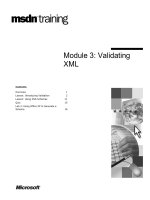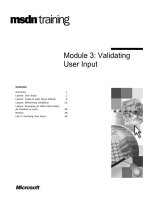Tài liệu Module 3: Identifying Threats to Network Security pptx
Bạn đang xem bản rút gọn của tài liệu. Xem và tải ngay bản đầy đủ của tài liệu tại đây (927.34 KB, 22 trang )
Contents
Overview 1
Lesson: Introduction to Security Threats 2
Lesson: Predicting Threats to Security 8
Lab A: Identifying Threats to Network
Security 15
Module 3: Identifying
Threats to Network
Security
Information in this document, including URL and other Internet Web site references, is subject to
change without notice. Unless otherwise noted, the example companies, organizations, products,
domain names, e-mail addresses, logos, people, places, and events depicted herein are fictitious,
and no association with any real company, organization, product, domain name, e-mail address,
logo, person, place or event is intended or should be inferred. Complying with all applicable
copyright laws is the responsibility of the user. Without limiting the rights under copyright, no
part of this document may be reproduced, stored in or introduced into a retrieval system, or
transmitted in any form or by any means (electronic, mechanical, photocopying, recording, or
otherwise), or for any purpose, without the express written permission of Microsoft Corporation.
Microsoft may have patents, patent applications, trademarks, copyrights, or other intellectual
property rights covering subject matter in this document. Except as expressly provided in any
written license agreement from Microsoft, the furnishing of this document does not give you any
license to these patents, trademarks, copyrights, or other intellectual property.
2002 Microsoft Corporation. All rights reserved.
Microsoft, MS-DOS, Windows, Windows NT, Active Directory, ActiveX, BizTalk, PowerPoint, Visio,
and Windows Media
are either registered trademarks or trademarks of Microsoft Corporation in the
United States and/or other countries.
The names of actual companies and products mentioned herein may be the trademarks of their
respective owners.
Module 3: Identifying Threats to Network Security iii
Instructor Notes
This module teaches students how to identify possible threats to a network and
understand common motivations of attackers. The module introduces threat
modeling as an effective way to predict where threats may occur in an
organization.
After completing this module, students will be able to:
Explain common network vulnerabilities and how attackers can exploit
them.
Predict threats to security by using the STRIDE (Spoofing, Tampering,
Repudiation, Information disclosure, Denial of service, Elevation of
privilege) threat model.
To teach this module, you need Microsoft
®
PowerPoint
®
file 2830A_03.ppt.
It is recommended that you use PowerPoint version 2002 or later to
display the slides for this course. If you use PowerPoint Viewer or an earlier
version of PowerPoint, all the features of the slides may not be displayed
correctly.
To prepare for this module:
Read all of the materials for this module.
Complete the practices.
Complete the lab and practice discussing the answers.
Read the additional reading for this module, located under Additional
Reading on the Web page on the Student Materials CD.
Visit the Web links that are referenced in the module.
Presentation:
45 minutes
Lab:
45 minutes
Required materials
Important
Preparation tasks
iv Module 3: Identifying Threats to Network Security
How to Teach This Module
This section contains information that will help you to teach this module.
Lesson: Introduction to Security Threats
Mention that these are simply a few of the more common types of attacks, but
there are many types of attacks that can threaten a network. If students ask
about security patches, tell them that these topics are covered in Module 6,
“Creating a Security Design for Computers.”
The key point of this page is that attacks can be very complex and elaborate.
Not all attacks are as simple as a virus infecting a network. Students must be
vigilant and be aware that there are many points at which a network may be
vulnerable to attack. Draw upon your own experience or recent news events to
describe attacks.
Other difficulties that you can discuss with students include large networks,
publicly available resources, supporting users for public networks, and users
who are connected to both public and private networks. Students may bring up
the issue of internal attackers. Tell them that some of this topic is covered in
Module 7, “Creating a Security Design for Accounts,” Appendix A, “Designing
an Acceptable Use Policy,” and Appendix B, “Designing Policies for Managing
Networks.”
Lesson: Predicting Threats to Security
Predicting threats and analyzing the risks involved forms the foundation of
security design. Threat modeling and risk analysis not only help determine the
countermeasures that students will select and design, but they also provide
justification to management for resource allocation. Emphasize to students
throughout the course that management may often be resistant to spending
money and resources on perceived threats. By carefully listing as many threats
as possible and the risks involved, students can persuade management of
security threats in language that management can understand. It will also help
security designers keep track of what threats management chooses to respond
to, and which threats it deems acceptable. Risk management is covered in
greater detail in Module 4, “Analyzing Security Risks.”
Students may feel overwhelmed when presented with the task of classifying
attacks according to a threat model. They may feel that modeling all potential
threats is a daunting task. Ensure them that the first time that they do threat
modeling it may take some time, but with experience it becomes easier.
Creating the team to model threats can be challenging. Encourage students to
use experienced personnel if possible, but also to choose objective participants.
The developer who created the application being modeled for threats may not
be able to conceive of any weaknesses in the application, or may
subconsciously steer the discussion away from vulnerabilities out of pride or
other emotions. In this example, the developer may provide useful technical
information for the team but may not be the most objective participant.
Common Types of
Network Vulnerabilities
How Network Attacks
Occur
Difficulties in Defending
Networks
The STRIDE Threat
Model
Steps for Predicting
Threats with a Threat
Model
Module 3: Identifying Threats to Network Security v
Assessment
There are assessments for each lesson, located on the Student Materials
compact disc. You can use them as pre-assessments to help students identify
areas of difficulty, or you can use them as post-assessments to validate learning.
Lab A: Identifying Threats to Network Security
To begin the lab, open Microsoft Internet Explorer and click the name of the
lab. Play the video interviews for students, and then instruct students to begin
the lab with their lab partners. Give students approximately 30 minutes to
complete this lab, and spend about 15 minutes discussing the lab answers as a
class.
In this lab, students review a network diagram of a proposed business-to-
business (B2B) infrastructure and a list of IP addresses. They then use a threat
modeling worksheet to record top threats to the B2B infrastructure.
In this lab, students do not send a reply e-mail to Ashley Larson.
Instead, they open a Microsoft Excel spreadsheet named Threat Model
Worksheet.xls and add information to it. Ensure that students rename the file
and save the spreadsheet to the Lab Answers folder on their desktops for
discussion.
This lab is slightly different from the previous lab in that students do not answer
the lab with an e-mail to Ashley Larson, but rather by saving their answers to a
spreadsheet on their desktops. Ensure that students understand this before
proceeding with the lab. Other labs may also require students to save files to
their desktops.
Ashley’s mail instructs students to find at least 10 threats, and at least one for
each STRIDE category. Without some type of scope, students may find the
exercise somewhat daunting. However, encourage students to find as many
threats as they can in the time allotted. Depending on the experience of the
students, consider assigning different STRIDE categories to different partners
or small teams.
The answers for this lab are located in the spreadsheet Lab Answers
3.xls, located in the Answers folder under Webfiles on the Student Materials
CD. Be sure to print the answers out and study them before you conduct the lab.
When discussing the lab answers, encourage groups of students to write their
top 10 threats on the whiteboard, and discuss students’ conclusions as a class.
The answers in the spreadsheet are suggested answers only. Encourage students
to find additional threats, such as inexperienced administrators. Also mention to
students that the spreadsheet is available to them on the Student Materials CD.
For general lab suggestions, see the Instructor Notes in Module 2, “Creating a
Plan for Network Security.” Those notes contain detailed suggestions for
facilitating the lab environment used in this course.
Important
Important
General lab suggestions
vi Module 3: Identifying Threats to Network Security
Customization Information
This section identifies the lab setup requirements for a module and the
configuration changes that occur on student computers during the labs. This
information is provided to assist you in replicating or customizing Microsoft
Official Curriculum (MOC) courseware.
This module includes only computer-based interactive lab exercises, and as a
result, there are no lab setup requirements or configuration changes that affect
replication or customization.
The lab in this module is also dependent on the classroom
configuration that is specified in the Customization Information section at the
end of the Automated Classroom Setup Guide for Course 2830A, Designing
Security for Microsoft Networks.
Lab Setup
There are no lab setup requirements that affect replication or customization.
Lab Results
There are no configuration changes on student computers that affect replication
or customization.
Important
Module 3: Identifying Threats to Network Security 1
Overview
*****************************
ILLEGAL FOR NON
-
TRAINER USE
******************************
In this module, you will learn how to identify possible threats to a network and
understand common motivations of attackers. The module introduces the
STRIDE (Spoofing, Tampering, Repudiation, Information disclosure, Denial of
service, Elevation of privilege) threat model as an effective way to predict
where threats may occur in an organization.
After completing this module, you will be able to:
Explain common network vulnerabilities and how attackers can exploit
them.
Predict threats to security by using the STRIDE model.
Introduction
Ob
jectives
2 Module 3: Identifying Threats to Network Security
Lesson: Introduction to Security Threats
*****************************
ILLEGAL FOR NON
-
TRAINER USE
******************************
A threat describes a danger or vulnerability. Threats can occur from a variety of
sources, such as attacks or an incorrectly configured application.
After completing this lesson, you will be able to:
Explain why network attacks occur.
Describe who attacks networks.
Describe common types of network vulnerabilities.
Describe how network attacks take place.
List the difficulties of defending networks.
Introduction
Lesson ob
jectives









